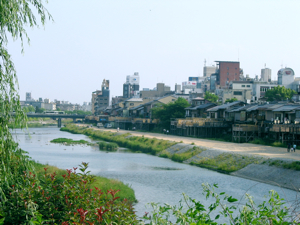2. The Standard Japanese VS the Kansai dialect

Map of Kansai Region |
The Japanese taught as a foreign language is what we call “Standard
Japanese.” Descriptively speaking, the Standard Japanese is the variety
used in the Tokyo area. The original ‘Standard Japanese” was in large
part the product of political considerations during the last half of
the
Meiji era (1868 -1912)
under the
Genbun itchi (the
unification of
the spoken and written language) movement, a movement dedicated to
present a united face to the world so that Japan would be perceived as
a civilized nation. Standard Japanese, based on the dialect of Tokyo
Yamanote area, has
personified
prestige and power since the
Meiji
government adopted it as the national language and began standardizing
language education in schools. Although the situation has not been the
same since WWII, Standard Japanese is still used as the representative
Japanese language on public occasions.
However, this does not mean that the regional dialects have
disappeared. Japan is a small island country, yet people from
different regions of the country speak differently even
nowadays. Differences among dialects can be found in phonetic (sounds),
accentual, lexical (words), morphological (word formation), or
morpho-syntactic (word conjugation in sentences) properties or
any combination of them. The Kansai dialect in Japan is considered to
be a “powerful” dialect historically and culturally, spoken by dozens
of millions of people who live or used to live in the Kansai area,
including major cities such as Osaka and Kyoto. In fact, the modern
Kansai dialect has inherited and still holds many characteristics of
classical Japanese, which is the origin of the modern Kansai dialect
and was the most powerful language when Kyoto and Nara were at their
respective times the seat of Japan’s early capitals and the center of
Japanese politics, economy and culture. Tokyo dialect was integrated as
a result of a change from the ancient Kansai dialect and gradually
became powerful as the political power in the
Edo (Tokyo) increased.
The Kansai dialect is thought to symbolize the strong local identity
of the people within the Kansai domestic culture. They tend to think of
their dialect as the “opposite” of the standard Japanese, rather than
merely one of the regional dialects in Japan. They are proud to be of
the Kansai people, and of the Kansai local culture. If you go to
bookstores in Japan, you will be surprised to find so many books deal
with the topic of Kansai – Tokyo rivalry. The Kansai people seem to
prefer local midnight TV shows in which the Kansai dialect is spoken to
other nationwide night shows. As a matter of fact, the Kansai dialect
cannot be separated from the local identity of the Kansai people. The
dialect is irreplaceable in some cases because of the strong connection
to its culture. For instance, the Kansai comedians retain and even take
advantage of the accent to express a sense of humor originating in the
Kansai identity and its culture. Even if it is the same joke, we could
never laugh if it was said in Standard Japanese!

鴨川 Kamo
River (Kyoto) |
As you
know, all language experiences some changes as time goes by,
and so has Kansai dialect. The Kansai dialect nowadays is different
from what it used to be a decade ago. Young people nowadays tend to use
what is called “neo-dialect” (the dialect affected by the Standard
Japanese). However, it still belongs to the Kansai dialect as long as
it retains the typical Kansai intonation pattern.
It is
also true that some Kansai dialect speakers acquire Standard
Japanese through public education (usually through written materials),
through media, through employee training in corporations, during
migration, from friends who speak the Standard, or by themselves out of
necessity. However, this does not mean they stop using the dialect.
They become “bidialectals,” having the Kansai dialect as a “we code,”
or as a code which represents their local identity.
Therefore, if you live in or visit the Kansai area and want to
belong to the Kansai people, you should try to greet them in their own
language - - i.e. to use their “we code.”


